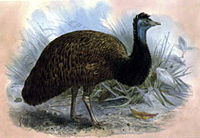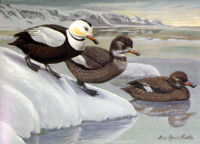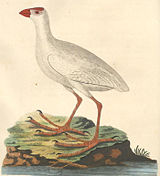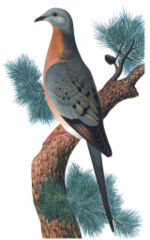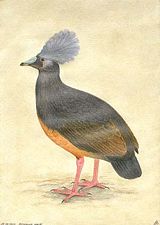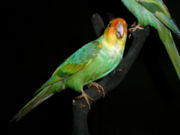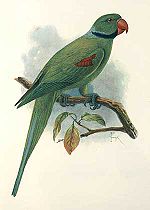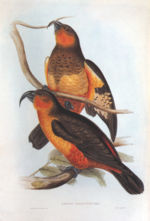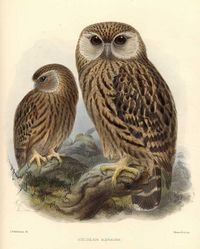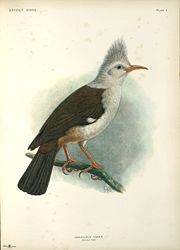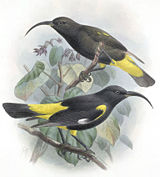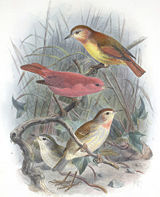List of extinct birds
2008/9 Schools Wikipedia Selection. Related subjects: Birds
- This page refers only to birds that have gone extinct in historical times and were subject to scientific study. For a list of early taxa of birds known only from fossils, see fossil birds. For birds extinct in Late Quaternary prehistoric times and (usually) known from specimens not completely fossilized, please refer to Late Quaternary prehistoric birds.
Since 1500, over 140 species of birds have become extinct, and this rate of extinction seems to be increasing. The situation is exemplified by Hawaii, where 30% of all known recently extinct species originally lived. Other areas, such as Guam, have also been hard hit; Guam has lost over 60% of its native species in the last 30 years, many of them due to the introduced Brown Tree Snake.
There are today about 10,000 species of birds, with roughly 1200 considered to be under threat of extinction. Except for a dozen or so species the threat is man-made.
Island species in general, and flightless island species in particular are most at risk. The disproportionate number of rails in the list reflects the tendency of that family to lose the ability to fly when geographically isolated. Even more rails became extinct before they could be described by scientists; these taxa are listed in Later Quaternary Prehistoric Birds.
The extinction dates given below are usually approximations of the actual date of extinction. In some cases, more exact dates are given as it is sometimes possible to pinpoint the date of extinction to a specific year or even day (the San Benedicto Rock Wren is possibly the most extreme example—its extinction could be timed with an accuracy of maybe half an hour). Extinction dates in the literature are usually the dates of the last verified record (credible observation or specimen taken); in many Pacific birds which became extinct shortly after European contact, however, this leaves an uncertainty period of over a century because the islands on which they used to occur were only rarely visited by scientists.
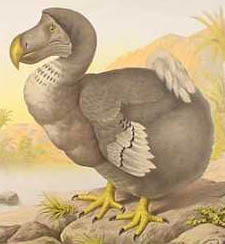
Extinct bird species
Struthioniformes
The Ostrich and related ratites.
- Elephant Bird, Aepyornis maximus and/or A. medius (Madagascar, 16th century?)
- The taxonomy of the elephant birds is not fully resolved; it is certain that at least one taxon survived until some 1000 years ago at least. Judging from geographical data, A. maximus and the smaller A. medius are possibilities.
- Lesser Megalapteryx, Megalapteryx didinus (South Island, New Zealand, late 15th century?)
- Generally believed to have been extinct by 1500, this is the only Moa species that according to current knowledge might have survived until later times, possibly as late as the 1830s.
- King Island Emu, Dromaius ater (King Island, Australia, 1822)
- Extinct in the wild c. 1805, the last captive specimen died in 1822 in the Jardin des Plantes.
- Kangaroo Island Emu, Dromaius baudinianus (Kangaroo Island, Australia, 1827)
- West Coast Spotted Kiwi, Apteryx occidentalis (South Island, New Zealand, c. 1900)
- A doubtful form known from a single bird; may be a Little Spotted Kiwi subspecies or a hybrid between that species and the Rowi.
Anseriformes
- Korean Crested Shelduck, Tadorna cristata (Northeast Asia, late 20th century?)
- A relict species from Northeast Asia. Officially critically endangered due to recent unconfirmed reports.
- Réunion Shelduck, Alopochen kervazoi (Réunion, Mascarenes, c.1690s)
- Mauritian Shelduck, Alopochen mauritianus (Mauritius, Mascarenes, c.1695)
- Amsterdam Island Duck, Anas marecula (Amsterdam Island, South Indian Ocean, c.1800)
- Mauritian Duck, Anas theodori (Mauritius and Réunion, Mascarenes, late 1690s)
- Mariana Mallard, Anas oustaleti (Marianas, West Pacific, 1981)
- Finsch's Duck, Chenonetta finschi from New Zealand possibly survived to 1870
- Pink-headed Duck, Netta caryophyllacea (East India, Bangladesh, North Myanmar, 1945?) – formerly Rhodonessa
- Officially critically endangered; recent surveys have failed to rediscover it.
- Réunion Pochard, Aythya cf. innotata (Réunion, Mascarenes, c.1690s)
- A bone of a pochard found on Réunion seems to resolve the reports of canards other than the Mauritian Duck having occurred on the island. The taxonomic status of this form cannot be resolved until more material is found, however.
- Labrador Duck, Camptorhynchus labradorius (Northeast North America, c.1880)
- Auckland Islands Merganser, Mergus australis (Auckland Islands, Southwest Pacific, c.1902)
Galliformes
Quails and relatives.
- The Pile-builder Megapode, Megapodius molistructor may have survived on New Caledonia to the late 18th century as evidenced by descriptions of the bird named "Tetrao australis" and later "Megapodius andersoni".
- The Viti Levu Scrubfowl, Megapodius amissus of Viti Levu and possibly Kadavu, Fiji, may have survived to the early 19th or even the 20th century as suggested by circumstantial evidence.
- Raoul Island Scrubfowl, Megapodius sp. (Raoul, Kermadec Islands, 1876)
- A megapode is said to have inhabited Raoul Island until the population was wiped out in a volcanic eruption. It is not clear whether the birds represent a distinct taxon or derive from a prehistoric introduction by Polynesian seafarers.
- New Zealand Quail, Coturnix novaezelandiae (New Zealand, 1875)
- Himalayan Quail, Ophrysia superciliosa (North India, late 19th century?)
- Officially critically endangered. Not recorded with certainty since 1876, but thorough surveys are still required, and there is a recent set of possible (though unlikely) sightings around Naini Tal in 2003. A little-known native name from Western Nepal probably refers to this bird, but for various reasons, no survey for Ophrysia has ever been conducted in that country, nor is it generally assumed to occur there (due to the native name being overlooked).
- The Double-banded Argus, Argusianus bipunctatus, was described based on a single aberrant feather piece from an unknown locality found in 1871. This is apparently a rather simple developmental aberration.
Charadriiformes
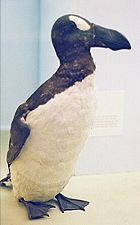
Shorebirds, gulls and auks.
- Javanese Lapwing, Vanellus macropterus (Java, Indonesia, mid-20th century)
- Officially classified as critically endangered, but as this conspicuous bird has not been recorded since 1940, it is almost certainly extinct.
- Tahitian Sandpiper, Prosobonia leucoptera (Tahiti, Society Islands, 19th century)
- White-winged Sandpiper, Prosobonia ellisi (Moorea, Society Islands, 19th century)
- Doubtfully distinct from P. leucoptera.
- Eskimo Curlew, Numenius borealis (Northern North America, late 20th century?)
- May still exist; officially classified as critically endangered, possibly extinct.
- Slender-billed Curlew, Numenius tenuirostris (Western Siberia, early 2000s?)
- May still exist; officially classified as critically endangered. A few birds were recorded in 2004, following several decades of increasing rarity. There was an unconfirmed sighting in Albania in 2007.
- Great Auk, Pinguinus impennis (North Atlantic, early 1850s)
- Canarian Black Oystercatcher, Haematopus meadewaldoi (Eastern Canary Islands, E Atlantic, c. 1940?)
- Later sightings of black oystercatchers off Senegal were not likely to be of this sedentary species, but two records from Tenerife - the last in 1981 - may be.
Gruiformes
Rails and allies.
" Leguat's Giant" or géant, a hypothetical giant rail from the Mascarenes described as Leguatia gigantea, is based on his descriptions of flamingos, as Leguat was not familiar with their French name flamand or thought that it referred to other birds (it was in his time sometimes used for spoonbills, for example).
- Antillean Cave-rail, Nesotrochis debooyi from Puerto Rico and the Virgin Islands possibly survived into the Modern Era.
- Hawkins' Rail, Diaphorapteryx hawkinsi (Chatham Islands, SW Pacific, 19th century)
- Red Rail, Aphanapteryx bonasia (Mauritius, Mascarenes, c. 1700)
- Rodrigues Rail, Aphanapteryx leguati (Rodrigues, Mascarenes, mid-18th century)
- Bar-winged Rail, Nesoclopeus poecilopterus (Fiji, Polynesia, c. 1980)
- New Caledonian Rail, Gallirallus lafresnayanus (New Caledonia, Melanesia, c. 1990?)
- Officially classified as critically endangered, the last records were in 1984 and it seems that all available habitat is overrun by feral pigs and dogs which prey on this bird.
- Wake Island Rail, Gallirallus wakensis (Wake Island, Micronesia, 1945)
- Tahiti Rail, Gallirallus pacificus (Tahiti, Society Islands, late 18th – 19th century)
- Dieffenbach's Rail, Gallirallus dieffenbachii (Chatham Islands, SW Pacific, mid-19th century)
- Sharpe's Rail, Gallirallus sharpei (Indonesia?, 20th century?)
- A bird known from a single skin of unknown origin. A research project has been proposed to shed light on its relationships and possible place of origin.
- Vava'u Rail, Gallirallus cf. vekamatolu (Vava'u, Tonga, early 19th century?)
- This bird is known only from a drawing by the 1793 Malaspina expedition, apparently depicting a species of Gallirallus. The 'Eua Rail, Gallirallus vekamatolu, is known from prehistoric bones found on 'Eua, but this species is almost certainly not G. vekamatolu, as that bird was flightless and hence is unlikely to have settled 3 distant islands. However, it probably was a close relative.
- The Norfolk Island Rail, Gallirallus sp. may be the bird shown on a bad watercolor illustration made around 1800
- Chatham Rail, Cabalus modestus (Chatham Islands, SW Pacific, c. 1900)
- Réunion Rail, Dryolimnas augusti (Réunion, Mascarenes, late 17th century)
- Red-throated Wood-rail, Aramides gutturalis (Peru, 20th century?)
- Usually considered a badly prepared specimen of the Grey-necked Wood Rail, the single known individual of this bird may prove a distinct species though.
- Ascension Flightless Crake, Mundia elpenor (Ascension, Island, Atlantic, late 17th century) – formerly Atlantisia
- St Helena Crake, Porzana astrictocarpus (St Helena, Atlantic, early 16th century)
- Laysan Rail, Porzana palmeri (Laysan Island, Hawaiian Islands, 1944)
- Hawaiian Rail, Porzana sandwichensis (Big Island, Hawaiian Islands, c. 1890)
- Kosrae Island Crake, Porzana monasa (Kosrae, Carolines, c. mid-late 19th century)
- Miller's Crake, Porzana nigra (Tahiti, Society Islands, c. 1800)
- Known only from paintings and descriptions; taxonomic status uncertain as the material is often believed to refer to the extant Spotless Crake.
- St Helena Swamphen, Aphanocrex podarces (St Helena, Atlantic, 16th century) – formerly Atlantisia
- Lord Howe Swamphen, Porphyrio albus (Lord Howe Island, SW Pacific, early 19th century)
- Réunion Swamphen or Oiseau bleu, Porphyrio coerulescens (Réunion, Mascarenes, 18th century)
- Known only from descriptions. Former existence of a Porphyrio on Réunion is fairly certain, but not proven to date.
- Marquesas Swamphen, Porphyrio paepae (Hiva Oa and Tahuata, Marquesas)
- May have survived to c. 1900. In the lower right corner of Paul Gauguin's 1902 painting Le Sorcier d'Hiva Oa ou le Marquisien à la cape rouge there is a bird which reminds of native descriptions of P. paepae.
- The North Island Takahē, Porphyrio mantelli known from subfossil bones found on North Island, New Zealand, may have survived to 1894 or later.
- New Caledonia Swamphen, Porphyrio kukwiedei from New Caledonia, Melanesia, may have survived into historic times. The native name n'dino is thought to refer to this bird.
- Samoan Wood Rail, Gallinula pacifica (Savai'i, Samoa, 1907?)
- Probably better placed in the genus Pareudiastes, unconfirmed reports from the late 20th century suggest it still survives in small numbers, and therefore it is officially classified as critically endangered.
- Makira Wood Rail, Gallinula silvestris (Makira, Solomon Islands, mid-20th century?)
- Only known from a single specimen, this rail is probably better placed in its own genus, Edithornis. There are some unconfirmed recent records that suggest it still survives, thus, it is officially classified as critically endangered.
- Tristan Moorhen, Gallinula nesiotis (Tristan da Cunha, Atlantic, late 19th century)
- Mascarene Coot, Fulica newtoni (Mauritius and Réunion, Mascarenes, c. 1700)
- Rallidae gen. et sp. indet.
- Unknown rail from Amsterdam Island, one specimen found but not recovered. Extinct by 1800 or may have been straggler of extant species.
- Fernando de Noronha Rail, Rallidae gen. et sp. indet. (Fernando de Noronha, W Atlantic, 16th century?)
- A distinct species of rail inhabited Fernando de Noronha island, but it has not been formally described yet. Probably was extant at Western contact.
- Tahitian "Goose", Rallidae gen. et sp. indet. (Tahiti, late 18th century?)
- Early travellers to Tahiti reported a "goose" that was found in the mountains. Altogether, a species of the rail genus Porphyrio seems the most likely choice.
Podicipediformes
Grebes.
- Colombian Grebe, Podiceps andinus (Bogotá area, Colombia, 1977)
- Alaotra Grebe, Tachybaptus rufolavatus (Lake Alaotra, Madagascar, late 1980s?)
- Officially critically endangered, possibly extinct, declined through habitat destruction and hybridization with the Little Grebe. Disappeared from only known location in the 1980s.
- Atitlán Grebe, Podilymbus gigas (Lake Atitlán, Guatemala, 1989)
Ciconiiformes
Herons and related birds.
The "Painted Vulture" (Sarcorhamphus sacra), a Floridan bird supposedly similar to the King Vulture, seems based on a misidentification of the Crested Caracara. See King Vulture article for discussion.
- Bermuda Night Heron, Nyctanassa carcinocatactes (Bermuda, West Atlantic, 17th century)
- Sometimes assigned to the genus Nycticorax
- Réunion Night Heron, Nycticorax duboisi (Réunion, Mascarenes, late 17th century)
- Mauritius Night Heron, Nycticorax mauritianus (Mauritius, Mascarenes, c. 1700)
- Rodrigues Night Heron, Nycticorax megacephalus (Rodrigues, Mascarenes, mid-18th century)
- Ascension Night Heron, Nycticorax olsoni (Ascension Island, Atlantic, late 16th century?)
- Known only from subfossil bones, but the description of a flightless Ascension bird by F. André Thevet cannot be identified with anything other than this species.
- New Zealand Little Bittern, Ixobrychus novaezelandiae (New Zealand, late 19th century)
- Long considered to be vagrant individuals of the Australian Little Bittern, bones recovered from Holocene deposits indicate that this was indeed a distinct taxon, but it might not be a separate species.
- Réunion Sacred Ibis, Threskiornis solitarius (Réunion, Mascarenes, early 18th century)
- This species was the basis of the "Réunion Solitaire", a supposed relative of the Dodo and the Rodrigues Solitaire. Given the fact that ibis, but no dodo-like bones were found on Réunion and that old descriptions match a flightless Sacred Ibis quite well, the "Réunion Solitaire" hypothesis has been refuted.
Pelecaniformes
Cormorants and related birds.
- Spectacled Cormorant, Phalacrocorax perspicillatus (Komandorski Islands, North Pacific, c. 1850)
Procellariiformes
Petrels, shearwaters, albatrosses and storm-petrels.
- Small St Helena Petrel, Bulweria bifax (St Helena, Atlantic, early 16th century)
- Bermuda Shearwater, Puffinus parvus (Bermuda, West Atlantic, 16th century)
- Large St Helena Petrel, Pseudobulweria rupinarum (St Helena, Atlantic, early 16th century)
- Jamaica Petrel, Pterodroma caribbaea (Jamaica, West Indies)
- Possibly a subspecies of the Black-capped Petrel; unconfirmed reports suggest it might survive. Officially classified as critically endangered, possibly extinct.
- Pterodroma cf. leucoptera (Mangareva, Gambier Islands, 20th century?)
- A wing of a carcass similar to Gould's Petrel was recovered on Mangareva in 1922, where it possibly bred. No such birds are known to exist there today.
- Guadalupe Storm-petrel, Oceanodroma macrodacyla (Guadalupe, East Pacific, 1910s)
- Officially critically endangered, possibly extinct, but a thorough survey in 2000 concluded the species was certainly extinct.
Sphenisciformes
- The Chatham Islands Penguin, Eudyptes sp. (Chatham Islands, SW Pacific), is only known from subfossil bones, but a bird kept captive at some time between 1867 and 1872 might refer to this taxon.
Columbiformes
- St Helena Dove, Dysmoropelia dekarchiskos, possibly survived into the Modern Era.
- Passenger Pigeon, Ectopistes migratorius (Eastern North America, 1914)
- The passenger pigeon was once probably the most common bird in the world, a single flock numbering up to several billion birds. It was hunted close to extinction for food and sport in the late 19th century. The last individual died in the Cincinnati Zoo in 1914.
- The Silvery Pigeon, Columba argentina, has not been reliably observed since 1931 and may be extinct. It is difficult to distinguish from the common Pied Imperial Pigeon, however.
- Bonin Woodpigeon, Columba versicolor (Nakodo-jima and Chichi-jima, Ogasawara Islands, c. 1890)
- Ryukyu Woodpigeon, Columba jouyi (Okinawa and Daito Islands, Northwest Pacific, late 1930s)
- Réunion Pink Pigeon, Streptopelia duboisi (Réunion, Mascarenes, c. 1700)
- Its generic allocation is not fully resolved. There seems to have been at least another species of pigeon on Réunion (probably an Alectroenas), but bones have not yet been found. It disappeared at the same time.
- Rodrigues Turtle Dove, Streptopelia rodericana (Rodrigues, Mascarenes, before 1690?)
- Its generic allocation is not fully resolved. A possible subspecies of the Madagascar Turtle Dove, this seems not to be the bird observed by Leguat. Introduced rats might have killed it off in the late 17th century.
- Liverpool Pigeon, "Caloenas" maculata
- Also known as the Spotted Green Pigeon, the only specimen has been in Liverpool Museum since 1851, and was probably collected on a Pacific island for Edward Stanley, 13th Earl of Derby. It has been suggested that this bird came from Tahiti based on native lore about a somewhat similar extinct bird called titi, but this has not been verified.
- Sulu Bleeding-heart, Gallicolumba menagei (Tawitawi, Philippines, late 1990s?)
- Officially listed as critically endangered. Only known from 2 specimens taken in 1891, there have been a number of unconfirmed reports from all over the Sulu Archipelago in 1995. However, these reports stated that the bird had suddenly undergone a massive decline, and by now, habitat destruction is almost complete. If not extinct, this species is very rare, but the ongoing civil war prevents comprehensive surveys.
- Norfolk Island Ground-dove, Gallicolumba norfolciensis (Norfolk Island, Southwest Pacific, c. 1800)
- Tanna Ground-dove, Gallicolumba ferruginea (Tanna, Vanuatu, late 18th-19th century)
- Only known from descriptions of 2 now-lost specimens.
- Thick-billed Ground-dove, Gallicolumba salamonis (Makira and Ramos, Solomon Islands, mid-20th century?)
- Last recorded in 1927, only 2 specimens exist. Declared extinct in 2005.
- Choiseul Crested Pigeon, Microgoura meeki (Choiseul, Solomon Islands, early 20th century)
- Red-moustached Fruit-dove, Ptilinopus mercierii (Nuku Hiva and Hiva Oa, Marquesas, mid-20th century)
- Two subspecies, the little-known P. m. mercierii of Nuku Hiva (extinct mid-late 19th century) and P. m. tristrami of Hiva Oa.
- Negros Fruit-dove, Ptilinopus arcanus (Negros, Philippines, late 20th century?)
- Known only from one specimen taken at the only documented sighting in 1953, the validity of this species has been questioned, but no good alternative to distinct species status has been proposed. Officially critically endangered, it might occur on Panay, but no survey has located it. One possible record in 2002 seems not to have been followed up.
- Mauritius Blue Pigeon, Alectroenas nitidissima (Mauritius, Mascarenes, c. 1830s)
- Farquhar Blue Pigeon, Alectroenas sp. (Farquhar Group, Seychelles, 19th century)
- Only known from early reports; possibly a subspecies of the Comoro or Seychelles Blue Pigeon.
- Rodrigues Grey Pigeon, "Alectroenas" rodericana (Rodrigues, Mascarenes, mid-18th century)
- A mysterious bird of unknown affinities, known from a few bones and, as it seems, two historical reports.
- Dodo, Raphus cucullatus (Mauritius, Mascarenes, late 17th century)
- Called Didus ineptus by Linnaeus. A meter-high flightless bird found on Mauritius. Its forest habitat was lost when Dutch settlers moved to the island and the dodo's nests were destroyed by the monkeys, pigs, and cats the Dutch brought with them. The last specimen was killed in 1681, only 80 years after the arrival of the new predators. See also dodo tree.
- Rodrigues Solitaire, Pezophaps solitaria (Rodrigues, Mascarenes, c. 1730)
- For the "Réunion Solitaire", see Réunion Sacred Ibis.
Psittaciformes
- New Caledonian Lorikeet, Charmosyna diadema (New Caledonia, Melanesia, mid-20th century?)
- Officially critically endangered, there have been no reliable reports of this bird since the early 20th century. It is, however, small and inconspicuous.
- Norfolk Island Kākā, Nestor productus (Norfolk and Philip Islands, SW Pacific, 1851?)
- Society Parakeet, Cyanoramphus ulietanus (Raiatea, Society Islands, late 18th century)
- Black-fronted Parakeet, Cyanoramphus zealandicus (Tahiti, Society Islands, c. 1850)
- Paradise Parrot, Psephotus pulcherrimus (Rockhampton area, Australia, late 1920s)
- The Night Parrot, Pezoporus occidentalis, officially critically endangered, is a mysterious species which is possibly close to extinction. It was only reliably recorded twice in the late 20th century, the last time in 1991. More probably, it still persists in small numbers as an immature bird was found dead in Diamantina National Park in late 2006
- The Oceanic Eclectus Parrot, Eclectus infectus, known from subfossil bones found on Tonga, Vanuatu, and possibly Fiji, may have survived until the 18th century: a bird which seems to be a male Eclectus parrot was drawn in a report on the Tongan island of Vavaʻu by the Malaspina expedition. Also a 19th century Tongan name ʻāʻā ("parrot") for "a beautiful bird found only at ʻEua" is attested (see here under "Kaka"). This seems to refer either E. infectus which in Tonga is only known from Vavaʻu and ʻEua, or the extirpated population of the Collared Lory which also occurred there. It is possible but unlikely that the species survived on ʻEua until the 19th century.
- Seychelles Parakeet, Psittacula wardi (Seychelles, W Indian Ocean, 1883)
- Newton's Parakeet, Psittacula exsul (Rodrigues, Mascarenes, c. 1875)
- Mascarene Parrot, Mascarinus mascarinus (Réunion and possibly Mauritius, Mascarenes, 1834?)
- Last known individual was a captive bird which was alive before 1834.
- Broad-billed Parrot, Lophopsittacus mauritianus (Mauritius, Mascarenes, 1680?)
- May have survived to the late 18th century. A smaller related form described as Mauritius Grey Parrot (Lophopsittacus bensoni) may be the female of L. mauritianus.
- Rodrigues Parrot, Necropsittacus rodericanus (Rodrigues, Mascarenes, late 18th century)
- The species N. francicus is fictional, N. borbonicus most likely so.
- Glaucous Macaw, Anodorhynchus glaucus (N Argentina, early 20th century)
- Officially critically endangered due to persistent rumours of wild birds, but probably extinct.
- Cuban Red Macaw, Ara tricolor (Cuba, West Indies, late 19th century)
- A number of related species have been described from the West Indies, but are not based on good evidence. Several prehistoric forms are now known to have existed in the region, however.
- Carolina Parakeet, Conuropsis carolinensis (SE North America, c. 1930?)
- Although the date of the last captive bird's death in the Cincinnati Zoo, 1918, is generally given as extinction date, there are convincing reports of some wild populations persisting until later. 2 subspecies, C. c. carolinensis (east and south of the Appalachian range – extinct 1918 or c. 1930) and C. c. ludovicianus (Louisiana Parakeet, west of the Appalachian range – extinct early 1910s).
- Guadeloupe Parakeet, Aratinga labati (Guadeloupe, West Indies, late 18th century)
- Only known from descriptions, the former existence of this bird is likely for biogeographic reasons and because details as described cannot be referred to known species.
- Sinú Parakeet, Pyrrhura subandina (Colombia, mid-20th century?)
- Recently recognized as a distinct species, this bird has a very restricted distribution and was last reliably recorded in 1940. It was not found during searches in 2004 and 2006 and seems to be extinct; relocation efforts continue but are hampered by the threat of armed conflict.
- Martinique Amazon, Amazona martinica (Martinique, West Indies, mid-18th century)
- Guadeloupe Amazon, Amazona violacea (Guadeloupe, West Indies, mid-18th century)
- The extinct amazon parrots were originally described after travelers' descriptions. Both are now considered valid extinct species closely related to the Imperial Amazon.
Cuculiformes
Cuckoos.
- Delalande's Coua, Coua delalandei (Madagascar, late 19th century?)
- St Helena Cuckoo, Nannococcyx psix (St Helena, Atlantic, 18th century)
Falconiformes
- Cuban Kite, Chondrohierax wilsonii (Cuba, West Indies, early 2000s?)
- Often considered a subspecies of the Hook-billed Kite, it is at least critically endangered. While a small remnant probably survives in eastern Cuba, it has not been seen for some years; recent efforts to find the birds have hitherto drawn a blank but continue.
- The Bermuda Hawk, Bermuteo avivorus, known from Late Quaternary bones from Bermuda (W Atlantic), might have survived to the early 17th century
- Guadalupe Caracara, Polyborus lutosus (Guadelupe, E Pacific, 1900 or 1903)
- Réunion Kestrel, Falco duboisi (Réunion, Mascarenes, c. 1700)
Strigiformes
Typical owls and barn-owls.
- Réunion Owl, Mascarenotus grucheti (Réunion, Mascarenes, late 17th century?)
- Mauritius Owl, Mascarenotus sauzieri (Mauritus, Mascarenes, c. 1850)
- Rodrigues Owl, Mascarenotus murivorus (Rodrigues, Mascarenes, mid-18th century)
- The preceding two species were variously placed in Bubo, Athene, "Scops" (=Otus), Strix, and Tyto before their true affinity was realized.
- New Caledonian Boobook, Ninox cf. novaeseelandiae (New Caledonia, Melanesia)
- Known only from prehistoric bones, but might still survive.
- Laughing Owl, Sceloglaux albifacies (New Zealand, 1914?)
- Two subspecies, S. a. albifacies (South Island and Stewart Island, extinct 1914?) and S. a. rufifacies (North Island, extinct c. 1870s?) – circumstantial evidence suggests small remnants survived until the early/mid-20th century.
- The Puerto Rican Barn-owl, Tyto cavatica, known from prehistoric remains found in caves of Puerto Rico, West Indies, may still have existed in 1912 given reports of the presence of cave-roosting owls.
- The Bahaman Barn-owl, Tyto pollens, known from prehistoric remains found on Andros (Bahamas), may have survived to the 16th century as indicated by the "Chickcharnie" legend.
- Siau Scops-owl Otus siaoensis (20th century?)
- Only known from the holotype collected in 1866. Endemic to the small volcanic island of Siau north of Sulawesi in Indonesia. Might still survive as there are ongoing rumours of scops-owls at Siau.
Caprimulgiformes
Caprimulgidae - Nightjars and nighthawks.
Reclusive ground-nesting birds that sally out at night to hunt for large insects and similar prey. They are easily located by the males' song, but this is not given all year. Habitat destruction represents currently the biggest threat, while island populations are threatened by introduced mammalian predators, notably dogs, cats, pigs and mongoose.
- Jamaican Pauraque, Siphonorhis americana (Jamaica, West Indies, late 19th century?)
- Reports of unidentifiable nightjars from the 1980s in habitat appropriate for S. americana suggest that this cryptic species may still exist. Research into this possibility is currently underway; pending further information, it is classified as critically endangered, possibly extinct.
- Cuban Pauraque, Siphonorhis daiquiri (Cuba, West Indies, prehistoric?)
- Described from subfossil bones in 1985. There are persistent rumors that this bird, which was never seen alive by scientists, may still survive. Compare Puerto Rican Nightjar and preceding.
Vaurie's Nightjar (Caprimulgus centralasicus) is only known from a single 1929 specimen from Xinjiang, China. It has never been found again, but the validity of this supposed species is seriously disputed. It was never refuted to be an immature female desert European Nightjar.
The Nechisar Nightjar (Caprimulgus solala) is known only from a single preserved wing of a bird roadkilled on the Nechisar plains in Ethiopia in 1990. Unlikely to be extinct, no dedicated effort has been made to relocate it.
Apodiformes
Swifts and hummingbirds.
- Coppery Thorntail, Discosura letitiae (Bolivia?)
- Known only from 3 trade specimens of unknown origin. Might still exist.
- Brace's Emerald, Chlorostilbon bracei (New Providence, Bahamas, late 19th century)
- Gould's Emerald, Chlorostilbon elegans (Jamaica or northern Bahamas, West Indies, late 19th century)
- Alfaro's Hummingbird, Amazilia alfaroana (Costa Rica, c.1900)
- Sometimes separated in Saucerottia and/or considered a subspecies of the Indigo-capped Hummingbird (as A./S. cyanifrons alfaroana), this bird is known only from a late 19th century specimen and has never been seen since.
- Bogota Sunangel, Heliangelus zusii (Colombia?)
- A mysterious bird known only from a single specimen of unknown origin. Might be a hybrid (although the specimen is very distinct) or might still exist.
- Turquoise-throated Puffleg, Eriocnemis godini (Ecuador, 20th century?)
- Officially classified as critically endangered, possibly extinct. Known only from 6 pre-1900 specimens, the habitat at the only known site where it occurred has been destroyed. However, the bird's distribution remains unresolved.
Coraciiformes
Kingfishers and related birds.
- Ryūkyū Kingfisher, Todiramphus (cinnamominus) miyakoensis (Miyako-jima, Ryukyu Islands, late 19th century)
- This was probably a subspecies of the Micronesian Kingfisher Todiramphus cinnamominus. Only seen once by scientists, in 1887; the specimen taken is somewhat damaged, making identification by other than molecular analysis difficult.
- Giant Hoopoe, Upupa antaois (St Helena, Atlantic, early 16th century)
Piciformes
Woodpeckers and related birds.
- Imperial Woodpecker, Campephilus imperialis (Mexico, late 20th century)
- This 60-centimeter-long woodpecker is officially listed as critically endangered, possibly extinct. Occasional unconfirmed reports come up, the most recent in late 2005.
- There is currently a major debate on whether the North American Ivory-billed Woodpecker (Campephilus principalis principalis) was indeed rediscovered in the White River National Wildlife Refuge of Arkansas in 2004. The Cuban Ivory-billed Woodpecker (Campephilus principalis bairdii) was last seen in 1987 and is generally considered extinct, but there are a few patches of habitat not yet surveyed.
Passeriformes
Perching birds.
Acanthisittidae – New Zealand "wrens"
- Stephens Island Wren, Xenicus lyalli (New Zealand, 1895?)
- The species famously (but erroneously) claimed to have been made extinct by a single cat named "Tibbles".
- Bush Wren, Xenicus longipes (New Zealand, 1972)
- 3 subspecies: X. l. stokesi (North Island, extinct 1955); X. l. longipes (South Island, extinct 1968(; X. l. variabilis (Stewart Island, extinct 1972).
Formicariidae – antpittas and antthrushes
- Táchira Antpitta, Grallaria chthonia (Venezuela, late 20th century?)
- Officially Critically Endangered, this species has not been recorded since 1956 and although some habitat still exists, it was not found in dedicated searches in the 1990s.
Meliphagidae – honeyeaters and Australian chats
- Kioea, Chaetoptila angustipluma (Big Island, Hawaiian Islands, 1860s)
- Hawaiʻi ʻŌʻō, Moho nobilis (Big Island, Hawaiian Islands, 1930s)
- Oʻahu ʻŌʻō, Moho apicalis (Oʻahu, Hawaiian Islands, mid-19th century)
- Molokaʻi ʻŌʻō, Moho bishopi (Molokaʻi and probably Maui, Hawaiian Islands, c. 1910 or 1980s)
- Kauaʻi ʻŌʻō, Moho braccatus (Kauaʻi, Hawaiian Islands, 1987)
- Chatham Island Bellbird, Anthornis melanocephala (Chatham Islands, Southwest Pacific, c. 1910)
- Unconfirmed records exist from the early-mid 1950s
Acanthizidae – scrubwrens, thornbills, and gerygones
- Lord Howe Gerygone, Gerygone insularis (Lord Howe Island, Southwest Pacific, c. 1930)
Pachycephalidae – whistlers, shrike-thrushes, pitohuis and allies
- Mangarevan Whistler, ?Pachycephala gambierana (Mangareva, Gambier Islands, late 19th century?)
- A mysterious bird of which no specimen exists today. It was initially described as a shrike, then classified as an Eopsalteria "robin", and may actually be an Acrocephalus warbler.
Dicruridae – monarch flycatchers and allies
- Maupiti Monarch, Pomarea pomarea (Maupiti, Society Islands, mid-19th century)
- Eiao Monarch, Pomarea fluxa (Eiao, Marquesas, late 1970s)
- Previously considered a subspecies of the Iphis Monarch, this is an early offspring of the Marquesan stock.
- Nuku Hiva Monarch, Pomarea nukuhivae (Nuku Hiva, Marquesas, mid-late 20th century)
- Previously considered a subspecies of the Marquesas Monarch, this is another early offspring of the Marquesan stock.
- Ua Pou Monarch, Pomarea mira (Ua Pou, Marquesas, c. 1986)
- Previously considered another subspecies of the Marquesas Monarch, this was a distinct species most closely related to that bird and the Fatuhiva Monarch.
- Guam Flycatcher, Myiagra freycineti (Guam, Marianas, 1983)
Corvidae – crows, ravens, magpies and jays
- Banggai Crow, Corvus unicolor (Banggai or Peleng Island, Indonesia, 20th century?)
- Officially critically endangered, it is known only from two specimens taken on an unspecified island at some date in the late 19th century, probably in 1884 or 1885. Possible sightings in 1981 and 1991, but no unequivocal recent records and amount of habitat destruction suggest this species is extinct.
Vangidae – vangas
- Short-toed Nuthatch Vanga, Hypositta perdita (Madagascar, mid-20th century?)
- An enigmatic bird known only from 2 recently fledged juveniles collected in 1931, it was not found during a thorough search in 1996.
† Turnagridae – piopios
- North Island Piopio, Turnagra tanagra (North Island, New Zealand, c. 1970?)
- Not reliably recorded since about 1900.
- South Island Piopio, Turnagra capensis (South Island, New Zealand, 1960s?)
- Two subspecies, T. c. minor from Stephens Island (extinct c. 1897) and the nominate T. c. capensis from the South Island mainland (last specimen taken in 1902, last unconfirmed record in 1963)
Callaeidae – New Zealand wattlebirds
- Huia, Heteralocha acutirostris (North Island, New Zealand, early 20th century)
Hirundinidae – swallows and martins
- White-eyed River Martin, Pseudochelidon sirintarae (Thailand, late 1980s?)
- Officially critically endangered, this enigmatic species is only known from migrating birds and it was last seen in 1986 at its former roost site. Recent unconfirmed repors suggest it may occur in Cambodia.
- Red Sea Swallow, Petrochelidon perdita (Red Sea area, late 20th century?)
- Known from a single specimen, this enigmatic swallow probably still exists, but the lack of recent records is puzzling. It is alternatively placed in the genus Hirundo.
Megaluridae – megalurid warblers or grass warblers
- Chatham Islands Fernbird, Bowdleria rufescens (Chatham Islands, New Zealand, c. 1900)
- Often placed in genus Megalurus, but this is based on an incomplete review of the evidence.
Cisticolidae – cisticolas and allies
- Tana River Cisticola, Cisticola restrictus (Kenya, 1970s?)
- A mysterious bird, found in the Tana River basin in small numbers at various dates, but not since 1972. Probably invalid, based on aberrant or hybrid specimens. An unconfirmed sighting was apparently in 2007 in the Tana River Delta.
Zosteropidae – white-eyes. Probably belong into Timaliidae.
- Lord Howe White-eye, Zosterops strenuus (Lord Howe Island, Southwest Pacific, c. 1918)
Timaliidae – Old World babblers
- Black-browed Babbler, Malacocincla perspicillata (Borneo?, Indonesia, 20th century?)
- Known from a single mid-19th century specimen, this bird may be extinct or could still exist. If the specimen label, usually considered erroneous in claiming "Java" as the bird's origin, is correct, it may have gone extinct earlier.
Sylvioidea incertae sedis
- Aldabra Brush-warbler, Nesillas aldabranus (Aldabra, Indian Ocean, c. 1984)
Muscicapidae – Old World flycatchers and chats
- Rueck's Blue Flycatcher, Cyornis ruckii (Malaysia or Indochina, 20th century?)
- An enigmatic bird known from 2 or 4 possibly migrant specimens, last recorded in 1918. Might exist in NE Indochina and might be a subspecies of the Hainan Blue Flycatcher.
Turdidae – thrushes and allies
- Grand Cayman Thrush, Turdus ravidus (Grand Cayman, West Indies, late 1940s)
- Bonin Thrush, Zoothera terrestris (Chichi-jima, Ogasawara Islands, c. 1830s)
- ʻĀmaui, Myadestes woahensis (Oʻahu, Hawaiian Islands, mid-19th century)
- Kāmaʻo, Myadestes myadestinus (Kauaʻi, Hawaiian Islands, 1990s)
- Olomaʻo, Myadestes lanaiensis (Hawaiian Islands, 1980s?)
- Officially critically endangered, possibly extinct because a possible location on Molokaʻi remains unsurveyed. Two subspecies are known from Lanaʻi (M. l. lanaiensis, extinct early 1930s), Molokaʻi (M. l. rutha, extinct 1980s?) and a possible third subspecies from Maui (extinct before late 19th century).
Sturnidae – starlings
- Kosrae Island Starling, Aplonis corvina (Kosrae, Carolines, mid-19th century)
- Mysterious Starling, Aplonis mavornata (Mauke, Cook Islands, mid-19th century)
- Tasman Starling, Aplonis fusca (Norfolk Island and Lord Howe Island, Southwest Pacific, c. 1923)
- Two subspecies, A. f. fusca – Norfolk Island Starling (extinct c. 1923); A. fusca hulliana – Lord Howe Starling (extinct c. 1919).
- Pohnpei Starling, Aplonis pelzelni (Pohnpei, Micronesia, c. 2000)
- Only one reliable record since 1956, in 1995, leaves the species' survival seriously in doubt.
- Bay Starling, Aplonis? ulietensis (Raiatea, Society Islands, between 1774 and 1850)
- Usually called "Bay Thrush" (Turdus ulietensis); a mysterious bird from Raiatea, now only known from a painting and some descriptions of a (now lost) specimen. Its taxonomic position is thus unresolvable at present, although for biogeographic reasons and because of the surviving description, it has been suggested to have been a honeyeater. However, with the discovery of fossils of the prehistorically extinct starling Aplonis diluvialis on neighboring Huahine, it seems likely that this bird also belonged into this genus.
- Bourbon Crested Starling, Fregilupus varius (Réunion, Mascarenes, 1850s)
- Rodrigues Starling, Necropsar rodericanus (Rodrigues, Mascarenes, late 18th century?)
- The bird variously described as Testudophaga bicolor, Necropsar leguati or Orphanopsar leguati which was considered to be identical with N. rodericanus (which is only known from fossils) was finally resolved to be based on a misidentified partially albinistic specimen of the Martinique Trembler (Cinclocerthia gutturalis)
Mimidae – mockingbirds and thrashers
- Cozumel Thrasher, Toxostoma guttatum (Cozumel, Caribbean, early 2000s?)
- The most recent possible extinction on this list. It is still unknown whether the tiny population rediscovered in 2004 survived Hurricanes Emily and Wilma in 2005. Unconfirmed records in April 2006 and October and December 2007.
Estrildidae – estrildid finches (waxbills, munias, etc)
- Black-lored Waxbill, Estrilda nigriloris (D.R. Congo, Africa, late 20th century?)
- An enigmatic waxbill not seen since 1950; because part of its habitat is in Upemba National Park it may survive.
Icteridae – grackles
- Slender-billed Grackle, Quiscalus palustris (Mexico, 1910)
Parulidae – New World warblers
- Bachman's Warbler, Vermivora bachmanii (Southern USA, c. 1990?)
- Officially critically endangered, possibly extinct
- Semper's Warbler, Leucopeza semperi (Saint Lucia, Caribbean, 1970s)
Ploceidae – Weavers
- Foudia delloni, new name for the Réunion Fody (Cheke & Hume 2008), known from travel reports by Gabriel Dellon in 1668 and Dubois (1674), Foudia bruante (S. Müller 1776) might be a colour morph of the Madagascar Weaver (Cheke & Hume 2008)
Fringillidae – true finches and Hawaiian honeycreepers
- Tawny-headed Mountain Finch, Leucosticte sillemi (Xinjiang, mid- or late 20th century?)
- An enigmatic bird known from just 2 specimens collected in 1929. As no threats are known, probably still extant, but the lack of recent records is puzzling.
- Bonin Grosbeak, Chaunoproctus ferreorostris (Chichi-jima, Ogasawara Islands, 1830s)
- ʻŌʻū, Psittirostra psittacea (Hawaiian Islands, c. 2000?)
- Officially classified as critically endangered, possibly extinct, this was once the most widespread species of Hawaiian honeycreeper. It has not been reliably recorded since 1987 or 1989.
- Lanaʻi Hookbill, Dysmorodrepanis munroi (Lanaʻi, Hawaiian Islands, 1918)
- Pila's Palila, Loxioides kikuichi (Kauaʻi, Hawaiian Islands), possibly survived to the early 18th century.
- Lesser Koa Finch, Rhodacanthus flaviceps (Big Island, Hawaiian Islands, 1891)
- Greater Koa Finch, Rhodacanthus palmeri (Big Island, Hawaiian Islands, 1896)
- Kona Grosbeak, Psittirostra kona (Big Island, Hawaiian Islands, 1894)
- Greater ʻAmakihi, Hemignathus sagittirostris (Big Island, Hawaiian Islands, 1901)
- Nukupuʻu, Hemignathus lucidus (Hawaiian Islands, c. 2000?)
- The subspecies from Oʻahu (H. l. lucidus) has been extinct since the late 19th century, that of Kauaʻi (H. l. hanapepe) most probably since the late 1990s and that of Maui (H. l. affinis) has not been reliably seen since 1995. It is currently classified as critically endangered, possibly extinct.
- Hawaiʻi ʻAkialoa or Lesser ʻAkialoa, Hemignathus obscurus (Big Island, Hawaiian Islands, 1940)
- Sometimes placed in genus Akialoa (as A. obscura).
- Greater ʻAkialoa, Hemignathus ellisianus (Kauaʻi, Oʻahu, Lanaʻi and prehistorically probably Maui and Molokaʻi, Hawaiian Islands, 1969)
- Sometimes placed in genus Akialoa (as A. ellisiana). Often split into Maui Nui ʻAkialoa, H. lanaiensis or A. lanaiensis (Lanaʻi and prehistorically probably Maui and Molokaʻi, Hawaiian Islands, extinct 1892), Oʻahu ʻAkialoa, H. ellisianus or A. ellisiana (Oʻahu, Hawaiian Islands, extinct 1940) and Kauaʻi ʻAkialoa, H. stejnegeri or A. stejnegeri (Kauaʻi, Hawaiian Islands, extinct 1969).
- Kakawahie, Paroreomyza flammea (Molokaʻi, Hawaiian Islands, 1963)
- Oʻahu ʻAlauahio, Paroreomyza maculata (Oʻahu, Hawaiian Islands, early 1990s?)
- Officially classified as critically endangered, possibly extinct. Last reliable record was in 1985, with an unconfirmed sighting in 1990.
- ʻUla-ʻai-hawane, Ciridops anna (Big Island, Hawaiian Islands, 1892 or 1937)
- Black Mamo, Drepanis funerea (Molokaʻi, Hawaiian Islands, 1907)
- Hawaiʻi Mamo, Drepanis pacifica (Big Island, Hawaiian Islands, 1898)
- Poʻo-uli, Melamprosops phaeosoma (Maui, Hawaiian Islands, 2004?)
- The most recent unequivocal extinction on this list. What was most likely the last known bird died in captivity on 28 November 2004.
Emberizidae – buntings and American sparrow
- Hooded Seedeater, Sporophila melanops (Brazil, 20th century?)
- Officially classified as critically endangered, possibly extinct. It is known only from a single male collected in 1823, and has variously been considered an aberrant Yellow-bellied Seedeater or a hybrid.
- Antioquia Brush-finch Atlapetes blancae (Antioquia, Colombia?)
- mysterious bird formerly misidentified as Slaty Brush-finch described in 2007 on basis of three 20th century museum specimens.
(Probably) Extinct subspecies of birds
Extinction of subspecies is a subject very dependent on guesswork. National and international conservation projects and research publications such as redlists usually focus on species as a whole. Reliable information on the status of threatened subspecies usually has to be assembled piecemeal from published observations such as regional checklists. Therefore, the following listing contains a high proportion of taxa that may just as well still exist, but are listed here due to any combination of absence of recent records, a known threat such as habitat destruction, or an observed decline.
Struthioniformes
The Ostrich and related ratites.
- Arabian Ostrich, Struthio camelus syriacus (Arabia, 1966) – Ostrich subspecies
- Tasmanian Emu, Dromaius novaehollandiae diemenensis (Tasmania, mid-19th century) – Emu subspecies
- North Island Little Spotted Kiwi, Apteryx owenii iredalei (North Island, New Zealand, late 19th century) – Little Spotted Kiwi subspecies
Tinamiformes
Tinamous
- Huila Black Tinamou, Tinamus osgoodi hershkovitzi (Colombia, 1980s?)
- A Black Tinamou subspecies or possibly a distinct species; not seen since 1976 but might persist in Cueva de los Guácharos National Park.
- Magdalena Tinamou, Crypturellus (erythropus) saltuarius (Colombia, late 20th century?)
- Variously considered a Red-legged Tinamou subspecies or a distinct species, this bird is only known from the 1943 type specimen. Recent research suggest it is still extant.
Anseriformes
- Bering Cackling Goose, Branta hutchinsii asiatica (Komandorskie and Kurile Islands, N Pacific, c. 1914 or 1929)
- A subspecies of the Cackling Goose (formerly "Lesser Canada Geese") which is doubtfully distinct from the Aleutian one.
- Coues' Gadwall or Washington Island Gadwall, Anas strepera couesi (Teraina, Kiribati, late 19th century)
- A doubtfully distinct Gadwall subspecies.
- Rennell Island Teal, Anas gibberifrons remissa (Rennell, Solomon Islands, c. 1959)
- A subspecies of the Sunda Teal which disappeared due to predation on young birds by the introduced tilapia Oreochromis mossambicus.
- Niceforo's Pintail, Anas georgica niceforoi (Colombia, 1950s) – Yellow-billed Pintail subspecies
- Borrero's Cinnamon Teal, Anas cyanoptera borreroi (Colombia, late 20th century?)
- A subspecies of the Cinnamon Teal known only from a restricted area in the Cordillera Occidental of Colombia, with a couple of records from Ecuador. It is either very rare or already extinct.
Galliformes
Quails and relatives.
- Italian Grey Partridge, Perdix perdix italica (Italy, c. 1990)
- A subspecies of the Grey Partridge whose validity has been questioned; the last purebred individuals disappeared during the late 1980s due to hybridization with introduced birds.
- Amik Gölü Black Francolin, Francolinus francolinus billypayni (S Turkey, possibly Lebanon, 1960s)
- A doubtfully distinct subspecies of the Black Francolin.
- Sicilian Black Francolin, Francolinus francolinus ssp. (Sicily, Mediterranean, c. 1869)
- Another doubtfully distinct Black Francolin subspecies.
- Heath Hen, Tympanuchus cupido cupido, (New England, North America, 1932)
- A subspecies of the Greater Prairie-Chicken or possibly a distinct species.
- New Mexico Sharp-tailed Grouse, Tympanuchus phasianellus hueyi (New Mexico, North America, 1954) – Sharp-tailed Grouse subspecies
- Moroccan Guineafowl, Numida meleagris sabyi (Morocco, mid-20th century or early 1980s)
- A subspecies of the Helmeted Guineafowl. Reportedly still kept in captivity in Morocco in late 1990s. Possibly extinct by 1950, the 3 1970s records may refer to feral domestic hybrids.
Charadriiformes
Shorebirds, gulls and auks.
- North Island Snipe, Coenocorypha aucklandica barrierensis (North Island, New Zealand, 1870s) – New Zealand Snipe subspecies
- South Island Snipe, Coenocorypha aucklandica iredalei (South and Stewart Islands, New Zealand, 1964) – New Zealand Snipe subspecies
- Tawitawi Small Buttonquail, Turnix sylvatica suluensis (Tawitawi, Philippines, mid-20th century) – Small Buttonquail subspecies
- New Caledonia Painted Buttonquail, Turnix varia novaecaledoniae (New Caledonia, Melanesia, early 20th century)
- A subspecies of the Painted Buttonquail of somewhat unclear status, it is variously considered anything between a hybrid between introduced species to a full species. Plentiful subfossil bones indicate that it was indeed a good endemic form.
- Kiritimati Sandpiper, Prosobonia cancellata cancellata (Kiritimati, Kiribati, 19th century?)
- The doubtfully distinct nominate subspecies of the Tuamotu Sandpiper, sometimes considered a distinct species, but only known from a painting.
Gruiformes
Rails and allies.
- Goldman's Yellow Rail, Coturnicops noveboracensis goldmani (Mexico, late 1960s) – Yellow Rail subspecies
- Macquarie Island Buff-banded Rail, Gallirallus philippensis macquariensis (Macquarie Islands, SW Pacific, 1880s) – Buff-banded Rail subspecies
- Raoul Island Banded Rail, Gallirallus philippensis ssp. (Raoul, Kermadec Islands, SW Pacific, late 19th century?)
- Reports of the former occurrence of the species on Raoul seem plausible enough, but they may relate to vagrant individuals of another Buff-banded Rail subspecies.
- Peruvian Rail, Rallus semiplumbeus peruvianus (Peru, 20th century?)
- A subspecies of the Bogota Rail which is known from a single specimen collected in the 1880s. It may still be extant.
- Western Australian Lewin's Rail, Lewinia pectoralis cleleandi (SW Australia, late 1930s) – Lewin's Rail subspecies
- Flores Lewin's Rail, Lewinia pectoralis exsul (Flores, Indonesia, late 20th century?)
- A Lewin's Rail subspecies known from vey few specimens. Only seen once since 1959 (in 1974) despite attempts to find it, it may well be extinct.
- Assumption White-throated Rail, Dryolimnas cuvieri abbotti (Assumption, Astove and Cosmoledo, Aldabra Islands, early 20th century) – White-throated Rail subspecies.
- Jamaican Uniform Crake, Amaurolimnas concolor concolor (Jamaica, West Indies, 1890) – Uniform Crake nominate subspecies
- Intact Rail, Gymnocrex plumbeiventris intactus (Melanesia, 20th century?)
- A subspecies of the Bare-eyed Rail which is known from a single specimen, c. mid-19th century, from the Solomon Islands or New Ireland. The taxon may be extant.
- Bornean Baillon's Crake, Porzana pusilla mira (Borneo, 20th century?)
- A subspecies of Baillon's Crake known from a single 1912 specimen and not found since; may be extinct, but species is hard to find.
- Iwo Jima White-browed Crake, Porzana cinerea brevipes (Iwo Jima and Minami Iōjima, Ogasawara Islands, early 20th century).
- A subspecies of the White-browed Crake that is often considered synonymous with the nominate.
- Moroccan Bustard, Ardeotis arabs lynesi (Morocco, 1990s)
- A subspecies of the Arabian Bustard. Last observed in 1993 at Lac Merzouga/Lac Tamezguidat.
- Luzon Sarus Crane, Grus antigone luzonica (Luzon, Philippines, late 1960s)
- A subspecies of the Sarus Crane which is not always accepted as valid, probably mainly because the specimens have never been thoroughly studied since the subspecies' description.
Ciconiiformes
Herons and related birds.
- Bonin Nankeen Night Heron, Nycticorax caledonicus crassirostris (Nakoudo-jima and Chichi-jima, Ogasawara Islands, c. 1890) – Nankeen Night Heron subspecies
- Principe Olive Ibis, Bostrychia olivacea rothschildi (Principe, Gulf of Guinea, 1990s?)
- An Olive Ibis subspecies, or (as B. bocagei rothschildi) one of the São Tomé Ibis if this is considered a distinct species. A probable sighting in 1994 was the first (and only) of these birds since the early 20th century; a population may yet survive.
Pelecaniformes
Cormorants and related birds.
- Tasman Booby, Sula dactylatra tasmani fide van Tets et al., 1988 (Lord Howe and Norfolk Islands, SW Pacific, c. 1790?)
- This is often regarded as a distinct species, but at best it is a subspecies of the Masked Booby. Probably identical to the extant Lord Howe Island population described as S. d. fullagari, which would in this case be named S. d. tasmani fide Holdaway & Anderson, 2001.
Pteroclidiformes
Sandgrouse.
- Fayyum Sandgrouse, Pterocles exustus floweri (Egypt, c. 1940)
- Chestnut-bellied Sandgrouse subspecies, may have survived until early 1980s.
Columbiformes
- Madeiran Wood Pigeon, Columba palumbus maderensis (Madeira, East Atlantic, early 20th century) – Wood Pigeon subspecies
- Ogasawara Japanese Woodpigeon, Columba janthina nitens (Ogasawara Islands, Northwest Pacific, 1980s) – Japanese Wood-pigeon subspecies
- Lord Howe Metallic Pigeon, Columba vitiensis godmanae (Lord Howe Island, Southwest Pacific, 1853) – Metallic Pigeon subspecies
- Tongan Metallic Pigeon, Columba vitiensis ssp. (Vava'u, Tonga, late 18th century?)
- This subspecies of the Metallic Pigeon is only known from a footnote in John Latham's "General History of Birds", and seems to have died out some time before 1800; possibly, the location is erroneous and the note really refers to the extant population of Fiji.
- Catanduanes Bleeding-heart, Gallicolumba luzonica rubiventris (Catanduanes, Philippines, late 20th century?)
- A subspecies of the Luzon Bleeding-heart known from a single specimen collected in 1971. It is either near extinction or already extinct.
- Basilan Bleeding-heart, Gallicolumba crinigera bartletti (Basilan, Philippines, mid-20th century?)
- A subspecies of the Mindanao Bleeding-heart, it was last reported in 1925 and given the massive habitat destruction is likely extinct.
- Vella Lavella Ground-dove, Gallicolumba jobiensis chalconota (Vella Lavella, Makira and Guadalcanal, Solomon Islands, late 20th century?)
- A subspecies of the White-breasted Ground-dove or possibly a distinct species. Known from only 4 specimens, there are no recent records and the local population report it has disappeared.
- White-headed Polynesian Ground-dove, Gallicolumba erythroptera albicollis (Central Tuamotu Islands, 20th century)
- The Central Tuamotu subspecies of the Polynesian Ground-dove, often referred to as G. e. pectoralis, disappeared at an undetermined date, but might still exist on some unsurveyed atolls. The identity of Northern Tuamotu populations, possibly still extant, is undetermined.
- Ebon Purple-capped Fruit-dove, Ptilinopus porphyraceus marshallianus (Ebon, Marshall Islands?, late 19th century?) – Purple-capped Fruit-dove subspecies
- Known from a single specimen collected in 1859, it is not certain whether this bird actually occurred on Ebon. All that can be said is that this subspecies is no longer found anywhere.
- Mauke Fruit-dove, Ptilinopus rarotongensis "byronensis" (Mauke, Cook Islands, mid- or late 19th century)
- A subspecies of the Rarotonga Fruit-dove, known only from the description of a now-lost specimen. the prehistorically extinct population on Mangaia is likely to belong to another distinct subspecies too.
- Negros Grey-necked Imperial-pigeon, Ducula carola nigrorum (Negros and probably Siquijor, late 20th century) – Grey-necked Imperial Pigeon subspecies
- Norfolk Island Kererū, Hemiphaga novaeseelandiae spadicea (Norfolk Island, Southwest Pacific, mid-19th century)
- A subspecies of the Kererū or New Zealand Pigeon. Similar birds were reported from Lord Howe Island; these seem to represent another extinct subspecies but are undescribed to date.
- Raoul Island Kererū, Hemiphaga novaeseelandiae ssp. nov (Raoul, Kermadec Islands, 19th century)
- Another undescribed subspecies (or possibly species) of the Kererū, known from bones and a brief report.
Psittaciformes
- Sangir Red and Blue Lory, Eos histrio histrio (Sangir Archipelago, Indonesia, c. 1997)
- The nominate subspecies of the Red and Blue Lory was hybridized out of existence by escaped trade individuals of the subspecies talautensis, the last purebred individuals disappearing in the 1990s or even much earlier.
- Challenger's Lory, Eos histrio challengeri (Nenusa Islands, Talaud Archipelago, early 20th century?)
- A supposed subspecies of the Red and Blue Lory, but probably invalid.
- Macquarie Island Red-crowned Parakeet, Cyanoramphus erythrotis erythrotis (Macquarie Islands, SW Pacific, c. 1891) – Subantarctic Red-crowned Parakeet nominate subspecies
- Lord Howe Island Red-fronted Parakeet, Cyanoramphus novaezelandiae subflavescens (Lord Howe Island, SW Pacific, c. 1870) – Red-crowned Parakeet subspecies
- Westerman's Eclectus Parrot, Eclectus roratus westermani (Indonesia, 20th century?)
- Known only from 16 captive birds specimens and last recorded in 1899, this enigmatic subspecies of the Eclectus Parrot is often considered an aviary hybrid. However, it may has well have occurred on islands at the northern or eastern end of the Banda Sea, becoming extinct some time in the 20th century – or might even still exist in a little-surveyed location.
- Réunion Parakeet, Psittacula eques eques (Réunion, Mascarenes, mid-18th century)
- Known only from a painting and descriptions; if it is accepted as valid, it would become the nominate subspecies of the Echo Parakeet, extant on Mauritius, which would then have to be called P. eques echo.
- Siquijor Colasisi, Loriculus philippensis siquijorensis (Siqujoor, Philippines, 1990s)
- A subspecies of the Colasisi or Philippine Hanging Parrot, either very rare or already extinct.
- Puerto Rican Parakeet, Aratinga chloroptera maugei (Mona and possibly Puerto Rico, West Indies, 1890s)
- A weakly differentiated subspecies of the Hispaniolan Parakeet.
- Sinú Brown-throated Parakeet, Aratinga pertinax griseipecta (Colombia, mid- or late 20th century?)
- A subspecies of the Brown-throated Parakeet known from only two specimens collected in 1949 and of unclear taxonomical and conservation status.
- Culebra Island Amazon, Amazona vittata gracilipes (Culebra, West Indies, 1900s)
- A weakly differentiated subspecies of the Puerto Rican Amazon which is itself highly endangered.
Cuculiformes
Cuckoos.
- Greater Crested Coua, Coua cristata maxima (SE Madagascar, late 20th century)
- Crested Coua subspecies, known only from a single specimen taken in 1950
- Timor Pheasant Coucal, Centropus phasianinus mui (Timor, Indonesia, late 20th century?)
- A very distinctive Pheasant Coucal subspecies or possibly a distinct species which is mysteriously only known from one specimen.
- Assumption Island Coucal, Centropus toulou assumptionis (Assumption Island, Seychelles, c. 1920s)
- A Madagascar Coucal subspecies often considered synonymous with the Aldabra form insularis, which has recolonized Assumption Island at a later date.
- Cabo San Lucas Groove-billed Ani, Crotophaga sulcirostris pallidula (Mexico, c. 1940)
- A weakly differentiated and probably invalid subspecies of the Groove-billed Ani
- Bahía Rufous-vented Ground Cuckoo, Neomorphus geoffroyi maximiliani (E Brazil, mid-20th century) – Rufous-vented Ground Cuckoo subspecies
Falconiformes
- Cape Verde Kite, Milvus (milvus) fasciicauda (Cape Verde Islands, E Atlantic, 2000)
- Considered either a subspecies of the Red Kite, a distinct species, or a hybrid between Red and Black Kites, the validity of this taxon has recently being questioned on the basis of molecular analysis. However, hybridization and a confusing molecular phylogeny of Red Kite populations coupled with the distinct phenotype of the Cape Verde birds suggest that the taxonomic status of this form is far from resolved.
- Anjouan Island Sparrowhawk, Accipiter francesii pusillus
- This subspecies of Frances's Sparrowhawk from Ndzouani (Anjouan), Comoros, was last seen in 1958; given that little habitat remains, it is probably extinct.
- Car Nicobar Sparrowhawk, Accipiter butleri butleri (Car Nicobar, Nicobar Islands, 20th century?)
- The nominate subspecies of the Nicobar Sparrowhawk – which is currently listed as vulnerable – is possibly extinct. It was last reliably recorded in 1901 and despite searches, has not been sighted after an unconfirmed record in 1977.
- Korean Sea-eagle, Haliaeetus pelagicus niger (Korea, 1950s)
- A Steller's Sea-eagle subspecies of uncertain distinctness.
- Volcano Islands Peregrine Falcon, Falco peregrinus furuitii. (Ogasawara Islands, 1940s)
- Peregrine falcon subspecies from the Ogasawara Islands. No sightings since 1945. A survey in 1982 failed to find this bird. Only known from Iwo Jima and Torishima.
Strigiformes
Typical owls and barn-owls.
- Sulu Reddish Scops Owl, Otus rufescens burbidgei (Sulu, Philippines, mid-20th century)
- A subspecies of the Reddish Scops Owl. Known from a single questionable specimen and may not be valid.
- Virgin Islands Screech Owl, Megascops nudipes newtoni (Virgin Islands, Caribbean, 1860s)
- A subspecies of the Puerto Rican Screech Owl of somewhat doubtful validity which occurred on several of the Virgin Islands, West Indies. The last reliable records are in 1860; it was not found in thorough surveys in 1995.
- Socorro Elf Owl, Micrathene whitneyi graysoni (Socorro, Revillagigedo Islands, c. 1970)
- A subspecies of the Elf Owl. Officially listed as critically endangered, the last specimen was taken in 1932, but there apparently still was a large population in 1958; it was not found by subsequent searches and appears to be extinct.
- Antiguan Burrowing Owl, Athene cunicularia amaura (Antigua, St Kitts and Nevis, West Indies, c. 1905) – Burrowing Owl subspecies
- Guadeloupe Burrowing Owl, Athene cunicularia guadeloupensis (Guadeloupe and Marie-Galante, West Indies, c. 1890) – Burrowing Owl subspecies
- Lord Howe Island Morepork, Ninox novaeseelandiae albaria (Lord Howe Island, Southwest Pacific, 1950s) – Southern Boobook subspecies
- Norfolk Island Morepork, Ninox novaeseelandiae undulata (Norfolk Island, Southwest Pacific, 1996)
- Individuals of the nominate subspecies were introduced in a last-ditch effort to save the local owl population. There now exists a hybrid population of a few dozen birds; the last individual of N. n. undulata, a female named Miamiti died in 1996.
- Cave-nesting Masked Owl, Tyto novaehollandiae troughtoni (Nullarbor Plain, Australia, 1960s)
- Doubtfully distinct from nominate subspecies, but differed behaviorally.
- Buru Masked Owl, Tyto sororcula cayelii (Buru, Indonesia, mid-20th century?)
- Subspecies of Lesser Masked Owl. Last recorded in 1921; the identity of a similar bird found on Seram remains to be determined. Seems to survive as an owl matching this bird's description was encountered in August, 2006.
- Peleng Masked Owl, Tyto rosenbergii pelengensis (Peleng, Banggai Islands, mid-20th century)
- Subspecies of Sulawesi Owl or separate species. Possibly extant, but only specimen known taken in 1938 and no further records.
- Samar Bay Owl, Phodilus badius riverae (Samar, Philippines, mid-20th century)
- Subspecies of Oriental Bay Owl or possibly distinct species. Taxonomy doubtful but only specimen lost in 1945 bombing raid so validity cannot be verified; no population exists on Samar today.
Caprimulgiformes
Nightjars and allies.
- New Caledonian White-throated Eared-nightjar, Eurostopodus mystacalis exsul (New Caledonia, Melanesia, mid-20th century)
- This distinct subspecies of the White-throated Eared-nightjar is possibly a separate species. It was found only once; due to its cryptic habits, it possibly still exists, but this is now considered unlikely.
Apodiformes
Swifts and hummingbirds.
- Alejandro Selkirk Firecrown, Sephanoides fernandensis leyboldi (Alejandro Selkirk Island, Juan Fernández Islands, Southeast Pacific, 1908) – Juan Fernández Firecrown subspecies
- Luzon Whitehead's Swiftlet, Collocalia whiteheadi whiteheadi (Luzon, Philippines, 20th century?)
- The nominate subspecies of Whitehead's Swiftlet is only known from four specimens collected at Mount Data in 1895 and from the lack of further records and the massive habitat destruction, it is usually considered extinct. Given the size of the island, it might still exist though.
Coraciiformes
Kingfishers and related birds.
- Sangihe Dwarf-kingfisher, Ceyx fallax sangirensis (Sangihe, Indonesia, 1998?)
- This subspecies of the Sulawesi Kingfisher was last seen in 1997 but not during a thorough survey one year later; it is either close to extinction or already extinct. Sometimes it is said to occur on Talaud Islands also, but this is erroneous.
- Rarotonga Kingfisher, Todiramphus cf. tutus (Rarotonga, Cook Islands, mid-1980s?)
- There exist reports of locals that kingfishers – probably a subspecies of the Chattering Kingfisher which is found on neighboring islands, but possibly vagrants from there – were found until around 1979, and there is a last record from 1984. Presently, no kingfishers are known to exist on Rarotonga.
- Mangareva Kingfisher, Todiramphus gambieri gambieri (Mangareva, Gambier Islands, late 19th century)
- Only known from a single 1844 specimen, the nominate subspecies of the Tuamotu Kingfisher was not found anymore when it was next searched for in 1922.
- Javan Blue-banded Kingfisher, Alcedo euryzona euryzona (Java, Indonesia, mid-20th century)
- The nominate subspecies of the Blue-banded Kingfisher; the last specimen was taken in 1937 and the last unconfirmed records are from the 1950s.
- Guadalcanal Little Kingfisher, Alcedo pusilla aolae (Guadalcanal, Solomon Islands) – Little Kingfisher subspecies
- Malaita Variable Kingfisher, Ceyx lepidus malaitae (Malaita, Solomon Islands) – Variable Kingfisher subspecies
- Sakarha Pygmy Kingfisher, Ispidina madagascariensis dilutus (Southwest Madagascar, late 20th century?)
- This subspecies of the Madagascar Pygmy Kingfisher is only known from one specimen taken in 1974 in an area where most habitat had already been lost.
- Ticao Tarictic Hornbill, Penelopides panini ticaensis (Ticao, Philippines, 1970s)
- A subspecies of the Tarictic Hornbill of somewhat uncertain status – possibly a distinct species, possibly a colour morph – the last confirmed report was in 1971 and it became extinct shortly thereafter.
Piciformes
Woodpeckers and related birds.
- Guadalupe Flicker, Colaptes cafer rufipileus (Guadalupe, East Pacific, c. 1910)
- A subspecies of the Red-shafted Flicker (or the Northern Flicker, as C. auratus rufipileus), it was last recorded in 1906 and not found anymore in 1911 and 1922. Recently, vagrant birds of a mainland subspecies have begun recolonizing the island as the habitat improves after the removal of feral goats.
- Javan Buff-rumped Woodpecker, Meiglyptes tristis tristis (Java, Indonesia, c. 1920)
- The nominate subspecies of the Buff-rumped Woodpecker became rare during the 19th century due to destruction of habitat. The last confirmed record was in 1880, and it obviously became extinct in the early 20th century.
- Northern White-mantled Barbet, Capito hypoleucus hypoleucus (Colombia, mid-20th century)
- The nominate subspecies of the White-mantled Barbet has not been seen since the late 1940s and its habitat has been almost completely destroyed.
- Botero White-mantled Barbet, Capito hypoleucus carrikeri (Colombia, mid-20th century)
- Another subspecies of the White-mantled Barbet, last seen in 1950.
- Todd's Jacamar, Brachygalba lugubris phaeonota (Brazil, late 20th century?)
- A subspecies of the Brown Jacamar, or possibly a hybrid, colour morph or full species. Might survive as it is only known from a remote and seldom visited area.
Passeriformes
Perching birds.
Pittidae – Pittas
- Bougainville Black-faced Pitta, Pitta anerythra pallida (Bougainville, Solomon Islands, mid-20th century)
- A subspecies of the Black-faced Pitta. Once common on Bougainville, but not recorded since 1938.
- Choiseul Black-faced Pitta, Pitta anerythra nigrifrons (Choiseul, Solomon Islands, late 20th century?)
- Another subspecies of the Black-faced Pitta. Not found anymore during recent searches; doubtful records from nearby islands.
Tyrannidae – Tyrant flycatchers
- Bogotá Bearded Tachuri, Polystictus pectoralis bogotensis (C Colombia, late 20th century?)
- A Bearded Tachuri subspecies or possibly a distinct species that has not been recorded for some time and is probably extinct.
- Grenadan Euler's Flycatcher – Lathrotriccus euleri flaviventris (Grenada, West Indies, early 1950s)
- A subspecies of Euler's Flycatcher, formerly known as Empidonax euleri johnstonei.
- San Cristóbal Vermilion Flycatcher, Pyrocephalus rubinus dubius (San Cristóbal, Galapagos, late 20th century?)
- A subspecies of Vermilion Flycatcher, described as extremely rare by David W. Steadman in the 1980s and not found despite a six-month survey in 1998. Sometimes considered as full species.
Furnariidae – Ovenbirds
- Peruvian Scale-throated Earthcreeper, Upucerthia dumetaria peruana (Peru, late 20th century?)
- A subspecies of the Scale-throated Earthcreeper, it is only known from 2 specimens taken in the early 1950s at Puno, Peru, and has never been found since. It might still exist, or have become extinct due to habitat destruction in the meantime.
- Northern Stripe-crowned Spinetail, Cranioleuca pyrrhophia rufipennis (N Bolivia, late 20th century?)
- A Stripe-crowned Spinetail subspecies known from a few specimens and not recorded since the 1950s; may be endangered or even extinct.
Formicariidae – Antpittas and antthrushes
- Northern Giant Antpitta, Grallaria gigantea lehmanni (Colombia, late 20th century?)
- A Giant Antpitta (or possibly Great Antpitta) subspecies apparently not recorded since the 1940s. Might still survive in Puracé National Park.
Pardalotidae – Pardalotes, scrubwrens, thornbills, and gerygones
- Western Rufous Bristlebird, Dasyornis broadbenti littoralis (Australia, 20th century) – Rufous Bristlebird subspecies
- King Island Brown Thornbill, Acanthiza pusilla archibaldi (King Island, Australia, early 1970s?)
- A Brown Thornbill subspecies which was last found in 1971, but there was an unconfirmed report in 2002 suggesting a small number is still extant.
Cinclosomatidae – Whipbirds and allies
- Mount Lofty Spotted Quail-thrush, Cinclosoma punctatum anachoreta (Australia, mid-1980s)
- A subspecies of the Spotted Quail-thrush, last recorded in 1984.
Dicruridae – Monarch flycatchers and allies
- Negros Celestial Monarch, Hypothymis coelestis rabori (Negros and possibly Sibuyan, Philippines, late 20th century?)
- A subspecies of the Celestial Monarch, not uncommon on Negros in 1959, but never recorded afterwards. A single Sibuyan specimen from an unspecified locality taken in the 19th century is the only record for this island.
- Hiva Oa Monarch, Pomarea mendozae mendozae (Hiva Oa and Tahuata, Marquesas, late 1970s) – Marquesas Monarch nominate subspecies
- Manu'a Shrikebill, Clytorhynchus vitiensis powelli (Manu'a Islands, Samoa, 1990s?)
- Usually treated as a subspecies of the Fiji Shrikebill but probably a distinct species, the American Samoan population declined due to habitat destruction and may have become extinct following the cyclones Ofa and Val.
- Lord Howe Fantail, Rhipidura fuliginosa cervina (Lord Howe Island, Southwest Pacific, c. 1925) – Grey Fantail subspecies
- Guam Rufous Fantail, Rhipidura rufifrons uraniae (Guam, Marianas, 1984) – Rufous Fantail subspecies
Campephagidae – Cuckoo-shrikes and trillers
- Cebu Bar-bellied Cuckoo-shrike, Coracina striata cebuensis (Cebu, Philippines, early 20th century) – Bar-bellied Cuckoo-shrike subspecies
- Maros Cicadabird, Coracina tenuirostris edithae (Sulawesi, mid-20th century)
- A subspecies of the Cicadabird known from a single specimen collected in 1931; quite possibly just a vagrant individual.
- Cebu Blackish Cuckoo-shrike, Coracina coerulescens altera (Cebu, Philippines, early 20th century?)
- A Blackish Cuckoo-shrike subspecies; possibly extant as the birds are rather unmistakable and a 1999 record therefore likely to be valid.
- Marinduque Blackish Cuckoo-shrike, Coracina coerulescens deschauenseei (Marinduque, Philippines, late 20th century?)
- Another Blackish Cuckoo-shrike subspecies, described from specimens collected in 1971, but apparently not seen since.
- Norfolk Island Long-tailed Triller, Lalage leucopyga leucopyga (Norfolk Island, Southwest Pacific, 1942)
- A subspecies of the Long-tailed Triller, possibly a distinct species.
Oriolidae – Orioles and Figbird
- Cebu Dark-throated Oriole, Oriolus xanthonotus assimilis (Cebu, Philippines, early 20th century) – Dark-throated Oriole subspecies
Corvidae – Crows, ravens, magpies and jays
- Pied Raven, Corvus corax varius morpha leucophaeus (Faroe Islands, 1948)
- A distinct local variety of the Icelandic subspecies of the Common Raven.
Callaeidae – New Zealand wattlebirds
- South Island Kōkako, Callaeas cinerea cinerea (South Island, New Zealand, 1960s?)
- The nominate subspecies of the Kōkako is usually considered extinct, as it has not been reliably recorded for decades. However, there are recent reports from Fiordland suggesting a population still exists.
Regulidae – Kinglets
- Guadalupe Ruby-crowned Kinglet, Regulus calendula obscurus (Guadalupe, East Pacific, 20th century?)
- A subspecies of the Ruby-crowned Kinglet that has not been found in recent times.
Hirundinidae – Swallows and martins
- Jamaican Golden Swallow, Tachycineta euchrysea euchrysea (Jamaica, West Indies, c. 1990?)
- The nominate subspecies of the Golden Swallow, endemic to Jamaica. The last major roost-site was destroyed in 1987, and the last confirmed sighting was in 1989. May still exist in the Cockpit Country, but probably extinct.
Phylloscopidae – phylloscopid warbers or leaf-warblers
- Eastern Canary Islands Chiffchaff, Phylloscopus canariensis exsul (Lanzarote and possibly Fuerteventura, Canary Islands, 1986?)
- A subspecies of the Canary Islands Chiffchaff, it became extinct in 1986 at latest, but probably much earlier, at some time in the first half of the 20th century.
Cettiidae – cettiid warblers or typical bush-warblers
- Babar Stubtail, Urosphena subulata advena (Babar, Indonesia, mid-20th century) – Timor Stubtail subspecies
- Western Turner's Eremomela, Eremomela turneri kalindei (Congo Basin, early 1980s)
- The West African subspecies of Turner's Eremomela has not been recorded since the end of the 1970s and habitat at the locations where it was once found is much reduced or destroyed. Placement in Cettiidae requires confirmation.
Acrocephalidae – acrocephalid warblers or marsh- and tree warblers
- Aguiguan Nightingale Reed-warbler, Acrocephalus luscinia nijoi (Aguiguan, Marianas, c. 1997)
- A subspecies of the Nightingale Reed-warbler of uncertain validity.
- Astrolabe Nightingale Reed-warbler, Acrocephalus luscinia astrolabii (Marianas?, mid-19th century?)
- A valid taxon, probably a subspecies of the Nightingale Reed-warbler, known from just 2 specimens found at an unknown location in the western Pacific.
- Pagan Nightingale Reed-warbler, Acrocephalus luscinia yamashinae (Pagan, Marianas, 1970s)
- Another doubtful subspecies of the Nightingale Reed-warbler.
- Laysan Millerbird, Acrocephalus familiaris familiaris (Laysan Island, Hawaiian Islands, late 1910s) – Millerbird subspecies
- Huahine Polynesian Warbler, Acrocephalus caffer garretti (Huahine, Society Islands, 19th century?)
- A poorly known subspecies of the Tahiti Reed-warbler.
- Raiatea Polynesian Warbler, Acrocephalus caffer musae (Raiatea, Society Islands, 19th century?)
- Another subspecies of the Tahiti Reed-warbler, known only from a drawing.
Pycnonotidae – Bulbuls
- Sumatra Blue-wattled Bulbul, Pycnonotus nieuwenhuisii inexspectatus (Sumatra, Indonesia, late 20th century?)
- A subspecies of the Blue-wattled Bulbul known from a single 1937 specimen. The entire "species" may be a hybrid.
- Cebu Streak-breasted Bulbul, Ixos siquijorensis monticola (Cebu, Philippines, early 20th century) – Streak-breasted Bulbul subspecies
Cisticolidae – Cisticolas and allies
- Northern White-winged Apalis, Apalis chariessa chariessa (Kenya, 1960s?)
- The nominate subspecies of the White-winged Apalis remains known only from the Tana River, a centre of endemism. It was last recorded in 1961.
Sylviidae – sylviid ("true") warblers and parrotbills
- Vanua Levu Long-legged Warbler, Trichocichla rufa clunei (Vanua Levu, Fiji, late 20th century?)
- A subspecies of the Long-legged Warbler; it was only found once, but there was an unconfirmed sighting in 1990. Placement in Sylviidae doubtful.
- Fayyum Warbler, Sylvia melanocephala/momus norissae (Egypt, c. 1940)
- A doubtfully distinct Sardinian Warbler subspecies.
Zosteropidae – White-eyes. Probably belong into Timaliidae
- Guam Bridled White-eye, Zosterops conspicillatus conspicillatus (Guam, Marianas, 1983) – Bridled White-eye nominate subspecies or possibly monotypic species.
- Seychelles Chestnut-sided White-eye, Zosterops mayottensis semiflava (Marianne Island, Seychelles, late 19th century). Extinct subspecies of the Chestnut-sided White-eye.
- Sometimes considered as full species
- Mukojima White-eye, Apalopteron familiare familiare (Mukojima Group, Ogasawara Islands, 1930s) – Bonin White-eye ("Bonin Honeyeater") subspecies
Timaliidae – Old World babblers
- Vanderbilt's Babbler, Malacocincla sepiarium vanderbilti (Sumatra, Indonesia, late 20th century?)
- An enigmatic subspecies of the Horsfield's Babbler, known from a single specimen. Not seen since the 1940s at the latest.
- Javan Large Wren-babbler, Napothera macrodactyla lepidopleura (Java, Indonesia, mid-20th century?)
- A Large Wren-babbler subspecies that is either very rare or already extinct.
- Burmese Jerdon's Babbler, Chrysomma altirostre altirostre (Myanmar, 1940s)
- The nominate subspecies of Jerdon's Babbler was last seen in 1941, but due to the lack of recent fieldwork, it might still exist.
" African warblers"
- Chapin's Crombec, Sylvietta leucophrys chapini (Congo Basin, late 20th century?)
- A subspecies of the White-browed Crombec, sometimes listed as a separate species. Restricted to the Lendu Plateau, it is either rare or already extinct.
Sylvioidea incertae sedis
- Amik Gölü Bearded Reedling, Panurus biarmicus kosswigi (S Turkey, 1970s) – Bearded Reedling subspecies
Troglodytidae – Wrens
- San Benedicto Rock Wren, Salpinctes obsoletus exsul (San Benedicto, Revillagigedo Islands, 1952)
- A subspecies of the Rock Wren which became extinct around 9 AM, August 1, 1952, when its island habitat was devastated by a massive volcanic eruption.
- Guadalupe Bewick's Wren, Thryomanes bewickii brevicauda (Guadalupe, East Pacific, late 1890s?) – Bewick's Wren subspecies
- An extinction date of "1903" seems to be in error; the last unquestionable record is apparently of 1897.
- San Clemente Bewick's Wren, Thyromanes bewickii leucophrys (San Clemente, East Pacific, 1940s) – Bewick's Wren subspecies
- Daito Winter Wren, Troglodytes troglodytes orii (Daito Islands, Northwest Pacific, c. 1940)
- A disputed Winter Wren subspecies; as it is known from a single specimen that may have been a vagrant individual, it is possibly invalid.
- Guadeloupe Wren, Troglodytes aedon guadeloupensis (Guadeloupe, Caribbean, late 20th century?)
- Found in 1914, 1969, 1970s; very rare or already extinct. Taxonomy unresolved. Part of the House Wren complex; other scientific names include T. musculus guadeloupensis and T. guadeloupensis
- Martinique Wren, Troglodytes aedon martinicensis (Martinique, Caribbean, c. 1890)
- Last found in 1886. Another House Wren complex taxon; other scientific names include T. musculus martinicensis and T. martinicensis.
Paridae – Tits, chickadees and titmice
- Daito Varied Tit, Poecile varia orii (Daito Islands, Northwest Pacific, c. 1940)
- A Varied Tit subspecies, variously placed in genus Sittiparus and Parus also. Not found in subsequent surveys in 1984 and 1986.
- Zagros Coal Tit, Periparus ater phaeonotus ( Zagros Mountains, South-western Iran)
- A Coal Tit subspecies, only known by the type specimen from 1870
Cinclidae – Dippers
- Cyprus Dipper, Cinclus cinclus olympicus (Cyprus, Northeast Mediterranean, 1950s)
- A subspecies of the White-throated Dipper of questionable validity.
Muscicapidae – Old World Flycatchers and chats
- Tonkean Henna-tailed Jungle Flycatcher, Rhinomyias colonus subsolanus (Sulawesi, Indonesia, late 20th century?)
- A Henna-tailed Jungle Flycatcher subspecies that is known from a single specimen; it may not be valid.
- Chinijo Chat, Saxicola dacotiae murielae (Chinijo Archipelago, Canary Islands, early 20th century) – Fuerteventura Chat subspecies
Turdidae – Thrushes and allies
- Norfolk Island Thrush, Turdus poliocephalus poliocephalus (Norfolk Island, Southwest Pacific, c. 1975) – Island Thrush subspecies
- Maré Island Thrush, Turdus poliocephalus mareensis (Maré, Melanesia, early 20th century)
- A subspecies of the Island Thrush, last collected in 1911 or 1912 and not found anymore in 1939.
- Lord Howe Island Thrush, Turdus poliocephalus vinitinctus (Lord Howe Island, Southwest Pacific, 1920s) – Island Thrush subspecies
- Lifou Island Thrush, Turdus poliocephalus pritzbueri (Lifou, Melanesia, early 20th century)
- Yet another subspecies of the Island Thrush. Similar birds still exist on Tanna, New Hebrides, but given the fact that the species readily differentiates into subspecies and that the distance between Tanna and Lifou is considerable, it is far from certain that the Tanna birds belong to this subspecies.
- Cauca Black-hooded Thrush, Turdus olivater caucae (Colombia, late 20th century?)
- A subspecies of the Black-hooded Thrush or possibly a distinct species. Not recorded for decades and at least highly threatened by deforestation.
- Peleng Red-and-black Thrush, Zoothera mendeni mendeni (Peleng, Indonesia, mid-20th century) – Red-and-black Thrush nominate subspecies
- Kibale Black-eared Ground Thrush, Zoothera cameronensis kibalensis (SW Uganda, late 20th century?)
- A Black-eared Ground Thrush subspecies known only from two 1966 specimens. Rare or possibly already extinct.
- Choiseul Russet-tailed Thrush, Zoothera heinei choiseuli (Choiseul, Solomon Islands, mid-20th century?)
- A subspecies of the Russet-tailed Thrush known from a single specimen found in 1924 and probably killed off by introduced cats, most likely in the 1940s.
- St Lucia Forest Thrush, Cichlherminia lherminieri sanctaeluciae (St Lucia, West Indies, 1980s)
- A subspecies of the Forest Thrush, last seen in 1980.
- Pines Solitaire, Myadestes elisabeth retrusus (Isla de la Juventud, West Indies, late 1930s?)
- A subspecies of the Cuban Solitaire. Unconfirmed records suggest it did still exist in the early 1970s.
Mimidae – Mockingbirds and thrashers
- Barbados Scaly-breasted Thrasher, Allenia fusca atlantica (Barbados, West Indies, c. 1990) – Scaly-breasted Thrasher subspecies
Estrildidae – Estrildid finches (waxbills, munias, etc)
- Southern Star Finch, Neochmia ruficauda ruficauda (Australia, c. 2000)
- A subspecies of the Star Finch; officially critically endangered but probably recently extinct. Not known to survive in captivity.
Ploceidae – Weavers
- Ruwet's Masked-weaver, Ploceus reichardi ruweti (D.R. Congo, late 20th century?)
- A subspecies of the Tanzania Masked-weaver, formerly considered a distinct species. No recent information on its status, and it may be a hybrid.
Fringillidae – True finches and Hawaiian honeycreepers
- San Benito House Finch, Carpodacus mexicanus mcgregori (San Benito, East Pacific, c. 1940s) – House Finch subspecies
- Lanaʻi ʻAlauahio, Paroreomyza montana montana (Lanaʻi, Hawaiian Islands, 1937)
- A subspecies of the Maui ʻAlauahio (or properly Maui Nui ʻAlauahio).
- Maui ʻAkepa, Loxops coccineus ochraceus (Maui, Hawaiian Islands, 1988) – ʻAkepa subspecies
- Oʻahu ʻAkepa, Loxops coccineus wolstenholmei (Oʻahu, Hawaiian Islands, 1990s) – ʻAkepa subspecies
- Laysan ʻApapane, Himatione (sanguinea) freethi (Laysan Island, Hawaiian Islands, 1923)
- The last individuals of this subspecies of the ʻApapane, possibly a distinct species, disappeared in a sandstorm, probably on the night of April 23/ April 24, 1923.
Icteridae – Grackles
- Grand Cayman Oriole, Icterus leucopteryx bairdi (Grand Cayman, West Indies, mid-20th century)
- A subspecies of the Jamaican Oriole, last reliably recorded in 1938.
Thraupidae – Tanagers
- Gonâve Western Chat-tanager, Calyptophilus tertius abbotti (Gonâve, West Indies, c. 1980?)
- A Western Chat-tanager subspecies last recorded in 1977 and probably extinct.
- Samaná Eastern Chat-tanager, Calyptophilus frugivorus frugivorus (E Hispaniola, West Indies, 1980s?)
- An Eastern Chat-tanager subspecies; the last (unconfirmed?) record was in 1982.
- Darwin's Large Ground-finch, Geospiza magnirostris magnirostris (Floreana?, Galapagos Islands, 1957?)
- The subspecies of the Large Ground-finch collected by Charles Darwin in 1835; he gave no precise locality. A similar bird was found in 1957, but no others have ever been seen.
- Saint Kitts Bullfinch, Loxigilla portoricensis grandis (Saint Kitts and prehistorically Barbuda, West Indies, 1930) – Puerto Rican Bullfinch subspecies
Emberizidae – Buntings and American sparrows
- Todos Santos Rufous-crowned Sparrow, Aimophila ruficeps sanctorum (Islas Todos Santos, E Pacific, 1970s) – Rufous-crowned Sparrow subspecies
- Dusky Seaside Sparrow, Ammodramus maritimus nigrescens (Florida, 1987) – Seaside Sparrow subspecies
- Guadalupe Spotted Towhee, Pipilo maculatus consobrinus (Guadalupe Island, East Pacific, c. 1900) – Spotted Towhee subspecies
